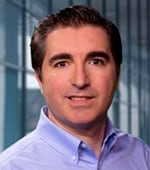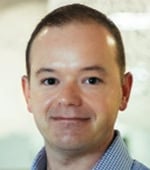Knowledge Institute Podcasts

-
Design, Digital Twins, and GenAI: AT&T's Network Evolution
January 07, 2025
Insights
- AT&T uses design thinking and AI-driven automation to streamline its massive, complex network, eliminating redundant systems and enhancing operational efficiency.
- AI in Action: By leveraging generative AI and digital twins, AT&T delivers actionable insights, improves workflows, and transforms both employee and customer experiences, setting new benchmarks for innovation in telecom.
"By listening to this podcast, you hereby acknowledge and understand that your personal data may be processed in the manner described in our Privacy Statement"

Chad Watt: Welcome to Ahead in the Cloud, where business leaders share what they've learned on their Cloud journey. I'm Chad Watt, Infosys Knowledge Institute researcher and writer.
Today, I'm speaking with Erian Laperi, Kristina Sutton, and Dan Wagner, from AT&T. Erian is an associate vice president focused on network simplification and transformation. Dan is a director in charge of digital twin and data analytics, and Kristina is a director for user experience. Welcome to you all.

Dan Wagner: Thank you.

Kristina Sutton: Thanks.

Chad Watt: Erian, tell us a little bit about your background and your current role at AT&T.

Erian Laperi: Well, Chad, first of all, I want to say thank you for the opportunity to have us here and tell our story and our journey.
My team is currently responsible for leading and developing next-generation AI and GenAI automation solutions and tools that help modernize and simplify processes and systems for our network teams. Our work is deeply rooted in design principles that put users and customers first. My team also leads the expansion of AT&T's digital twin capabilities that enable new business value creation by making analytics operational and operations more analytical.
My journey with AT&T started right out of college. It's an amazing technology company to work for that is obsessed with customer service and delighting customers. As you said, AT&T is a big company, but at heart, it has the spirit of an entrepreneurial and innovative small company, where one can have many careers, building on top of experiences and people networks.

Chad Watt: AT&T has a massive complex network. How have you simplified the operational and business support systems for that network?

Erian Laperi: Well, we've taken a holistic approach, Chad, to identifying areas of the business that we can simplify. When we kicked off the journey a few years ago, I saw a need to do things differently, so that this wasn't just another initiatives that lost steam after a couple of years. I'm a big believer in design thinking, and we championed creating, putting together our own design thinking team within the network organization, a vision that our leadership fully supported. By standing up this team to be focused solely on designing the experience that we want, we were able to approach this transformation differently than our other transformations in the past.
Today, we've provided recommendations and implemented many process and system changes that ultimately can eliminate significant number of legacy applications, removing duplications of tools and swiveled sharing, while driving cost out of the business. But most importantly, improving the experience of our employees and of our customers.

Chad Watt: Kristina, tell us how you use design thinking in this process.

Kristina Sutton: So since starting this journey, we've created, really, a whole ecosystem of practices and tools that we leverage to really start with the end user and learn about what they do and how they approach the problems that they need to solve. So we've designed a process and a practice that's both flexible enough to adapt to new information as we uncover it, but it's rigid enough that we can deliver these results very quickly.
So starting with the end user, we leverage design thinking to take a user-centric approach, so we really go into the field. We start with that end user, the technicians that are going to use our systems and tools that we're wanting to create. We start with constructing, actually, personas to identify the various work functions that these folks using the tool are going to do on a daily basis. From there, we job shadow. We conduct more interviews, leveraging all of our interview kits, and we observe people in the same role.
Sometimes for our smaller projects, just a few, but for our large-scale projects, we will chat with dozens of technicians before we can get to a point where we understand that function inside and out.

Chad Watt: That sounds like terrific front-end work and really kind of engaging, enjoyable work there. Tell us a little bit more about what value that delivers.

Kristina Sutton: So really, by starting with the end user and by championing the things that they need in a system or tool, we're really able to build a lot of trust, both with the development teams that we work with on a daily basis and the business SMEs that we partner with to help us transform the business.
So in 2024 alone, we delivered a technology roadmap that included a new application for all technicians, a new routing engine for all of our technicians, and a new workflow management system, again, for all of our technicians. In 2023, our NST program simplified how we build our network, consolidating more than 50 systems and tools into a unified workflow engine, which improved our construction cycle time and the overall quality of the build.

Chad Watt: Let me ask you to double-click on that. You deliver these new applications, these new products, these new tools. What's some new factor or new element to those things?

Kristina Sutton: Sure, so we actually have taken, with one of our products, multiple systems that our technicians currently have to use today, and we've put all of the information into one seamless front-end experience. So our technicians now can actually take a ticket, work their ticket, close the ticket, and move on to the next job, all in one system.
But what's most exciting about that is really how we're going to build on that in 2025 and 2026, by incorporating next-best action and recommendations for how to even do their jobs better.

Chad Watt: We're talking about AI in action. It's great.

Erian Laperi: And Chad, it's not just about making an upgrade into new technologies or consolidating from many tools to one tools. It's about making the experience simpler and better. In the example that Kristina mentioned, in one of the use cases, we went from 60-plus milestones to complete certain projects down to 20-plus milestones, allowing the AI and automation to handle manual tasks that otherwise our employees and engineers would have to handle manually.

Chad Watt: So Dan, you have a massive real-world network, and you've established a digital twin of that network. Give us your definition of digital twin and describe to me how AT&T makes use of that.

Dan Wagner: Yeah, our definition of a digital twin,, really is a semantic layer that represents the data, the logic, actions, and decisions that define our network and our business. It means it not only represents the physical elements of what we do but also the operational actions and the human elements that make everything possible. It's not just towers and circuits, but it's work orders and tickets and invoices and machine learning models, even more than that. Everything that enables AT&T to operate on a daily basis.
It's an extremely important and effective tool, and using the digital twin as the foundation for analytical operations, we enable workflows and things like ticket and alarm correlation, decommissioning of wireline equipment, cost reduction, circuit consolidation, and machine learning models that help us avoid dispatches.

Chad Watt: Your real-world network is dynamic and constantly evolving. How do you keep the digital twin up to date?

Dan Wagner: The digital twin itself is connected to the core systems in the network. It's all done via the ontology that we talked about. Really, that representation of the digital twin allowing us to easily add, change, adapt things as they rapidly develop. Things are changing all the time.

Chad Watt: Dan, you've applied design thinking. You've built a digital twin, and now you're using generative AI to make a network more efficient and resilient. What have you learned about making generative AI useful in this work?

Dan Wagner: Yeah, really, to make GenAI truly useful and to make it truly work, the enterprise must be able to incorporate it in operational workflows. Without an ontology that represents the digital twin of the network, we wouldn't have been able to do this so rapidly.
The ontology, really, is a language of generative AI. It allows us to use LLMs to quickly deploy workflows without developing domain-specific models for telco. That's the really important mark.

Chad Watt: Let's talk about information and wisdom, Erian. Machine learning, neural networks, and generative AI are effective at rewriting information. How do you use them to deliver valuable knowledge that empowers workers and benefits AT&T?

Erian Laperi: Yeah, so we do this through giving the employees the tools to use these technologies safely and effectively. Through Ask AT&T, which is our corporate GenAI platform, we ensure the safety and reliability of these cutting-edge technologies, along with the capabilities and tools for employees to do their jobs more effectively.

Chad Watt: Now, the specific example I've heard about is how you evaluate network transport lines that perhaps on the surface seem underused. How do you factor resilience and redundancy alongside efficiency when you're evaluating your network?

Erian Laperi: In this case, the GenAI evaluates the possibilities and the scenarios and makes recommendations that then are coded into the operational workflows that Dan mentioned earlier. An engineer still reviews the suggestions to ensure that we're making the right choices for AT&T and for our customers.

Chad Watt: Gotcha. You've got that human in the loop.

Erian Laperi: Absolutely.

Chad Watt: What is next for generative AI at AT&T?

Erian Laperi: Well, we expect these tools to continue to proliferate even farther, allowing AT&T to continuously improve the customer and employee experiences while also optimizing operational costs, so we can continue to invest in mobility networks and fiber.
AI-driven transformation is changing work. It's changing work artifacts and workflows across every role, function, and business process, and we are positioned to unlock value from these technologies better than anyone.

Chad Watt: What does it take to get professionals comfortable with generative AI and then using it an effective way?

Dan Wagner: Sure, the only thing that is constant in our business or in any business is change. We think of GenAI agents as an unlimited number of the best interns possible to help people with their roles. We don't replace what they do today, but they unlock new opportunities for everyone, enabling our engineers, our planners, designers, technicians, you name it, to do what they do every day, but even better.

Chad Watt: Erian, I understand you are sharing a lot of your AI-related work to telecom organizations responsible for setting industry standards. Why is that important for you to do?

Erian Laperi: Well, to reach scale and ensure that these technologies and capabilities are designed with the right security and privacy protections from the start, it is important that we collaborate together with others in the marketplace. It is the right thing to do, and it benefits our customers the most. AT&T provides essential services to our customers, and we want these services to work flawlessly across the network and across the nation.

Chad Watt: What is unique about AI and generative AI applied in telecom?

Erian Laperi: We have a duty and responsibility to our customers that is of utmost importance. Making sure that these systems are safe and secure is critical. We work with our partners in compliance, security, legal, and privacy to ensure that AT&T is doing what is right for our customers and employees.

Chad Watt: Great. What have you learned about AI that can be applied to other industries?

Erian Laperi: Well, regardless of industry chat, being able to use AI and generative AI in actual operational workflows is what's going to make all the difference. Chat bots are great, but we have to be able to convert the insights into actions. Those technologies and tools that enable that will go much farther today than just standard question-answering.

Chad Watt: Thank you for your time today, everyone. Is there anything else you'd like to add?

Erian Laperi: We want to thank you for the time and the opportunity, and as I mentioned at the beginning, AT&T is a large company but also has the heart and the spirit of an entrepreneurial small-company focus on innovation and delighting customers.
So I would really recommend to all of your listeners today, if they want to do an impact and do great things, come and explore doing those great things with AT&T.

Chad Watt: Great, thank you so much, Erian. Thank you, Kristina. Thank you, Dan.

Erian Laperi: Thank you.

Chad Watt: This podcast is part of our collaboration with MIT Tech Review, in partnership with Infosys Cobalt. Visit our content hub at technologyreview.com to learn more about how businesses across the globe are moving from cloud chaos to cloud clarity.
Be sure to follow Ahead in the Cloud wherever you get your podcasts. You can find more details in our show notes and transcripts at Infosys.com/iki. That's in our podcast section.
Thanks to our producers, Christine Calhoun and Yulia De Bari. Dode Bigley is our audio technician, and I'm Chad Watt with the Infosys Knowledge Institute, signing off. Until next time, keep learning and keep sharing.
About Erian Laperi

Erian is responsible for leading and developing next-generation AI automation solutions and tools that modernize and simplify processes and systems for AT&T's network teams. His work is rooted in user-centered design principles that prioritize both users and customers. He also oversees the expansion of AT&T’s digital twin capabilities, driving new business value by operationalizing analytics and enhancing operational efficiency through data-driven insights.
Erian began his career with AT&T in 2001 as a manager at the Southwestern Bell Houston Network Operations Center. Since then, he has held a variety of roles across multiple business units, including internal “startup” organizations such as SBC ASI, U-verse, AT&T Big Data, and Wayport/Superclick. In these roles, he managed global Wi-Fi service delivery, customer care, and field operations.
On LinkedIn
About Kristina Sutton

Kristina is a proven technology leader, with 15 years’ experience in driving transformation through user experience across multiple companies and industries. She passionately compels change in every role, with experience across user experience, design thinking, product management, and technology solutions. She successfully and repeatedly delivers desired outcomes while moving teams forward toward achieving goals. Kristina holds a Juris Doctor degree, with a specialty in Intellectual Property, as well as a Master of Science, a Master of Business Administration, and a Bachelor of Business Administration.
On LinkedIn
About Dan Wagner

Dan Wagner is a technology and analytics professional with over 15 years of experience leading data and AI initiatives across the enterprise. He has led and managed teams in technology operations, data analytics, AI & ML, and software delivery, and has worked in several different domains including Finance, Big Data, Corporate Strategy, Consumer, and Enterprise Business.
Dan currently leads the Gen AI program for AT&T’s Network Engineering and Operations organization as well as Digital Twin initiatives, data management, and cloud data warehouse operations. He holds a Bachelor of Science in Business Administration from Youngstown State University and an MBA from the University of Notre Dame.
On LinkedIn
About Chad Watt

Chad Watt is a researcher and writer for Infosys Limited and its thought leadership unit, the Infosys Knowledge Institute. His work covers topics ranging from cloud computing and artificial intelligence to healthcare, life sciences, insurance, financial services, and oil &gas. He joined Infosys in 2019 after a 20-plus years as a journalist, mostly covering business and finance. He most recently served as Southwest Editor for a global mergers and acquisitions newswire. He has reported from Dallas for the past 18 years, covering big mergers, scooping bank failures and profiling business tycoons. Chad previously reported in Florida (ask him about “hanging chads”) North Carolina and Texas. He earned a bachelor’s degree at Southern Methodist University and a master’s degree from Columbia University.
On LinkedIn
- “About the Infosys Knowledge Institute”
- MIT Technology Review
- AT&T
Mentioned in the podcast

